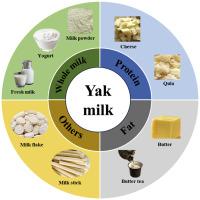青藏高原牦牛奶及其产品的系统回顾:独特的产品、化学成分、生物活性和微生物组成
IF 15.1
1区 农林科学
Q1 FOOD SCIENCE & TECHNOLOGY
引用次数: 0
摘要
背景近年来,由于消费者的口味偏好和健康意识的提高,消费者对特种奶的需求和兴趣日益增加。牦牛奶因其特殊的环境和营养特性而备受关注,被誉为 "天然浓缩奶"。本文全面回顾了牦牛和牦牛奶的历史、牦牛奶产品、化学成分(挥发性和非挥发性成分)、生物活性和微生物组成,并提出了进一步研究牦牛奶的机遇和挑战。主要发现和结论牦牛奶及其制品中含有多种生物活性成分,包括蛋白质、脂肪、脂肪酸、氨基酸、微量元素和维生素。其中,共轭亚油酸和免疫球蛋白的含量明显高于其他动物奶。其含量因物种、海拔和季节而异。在动物和体外研究中,牦牛奶及其成分被证明具有多种潜在的生物活性,包括抗氧化、抗高血压、抗菌、抗炎、抗缺氧和免疫调节活性。此外,了解牦牛奶及其产品的微生物组成对于质量控制和风味形成也至关重要。目前,由于牦牛奶产量低和生产环境的原因,牦牛奶及其产品的商业化受到限制,这就需要进一步探索牦牛奶的独特功能和优化生产工艺。本文章由计算机程序翻译,如有差异,请以英文原文为准。

A systemic review of yak milk and its products on the Qinghai-Tibet Plateau: Unique products, chemical composition, biological activities, and microbial composition
Background
In recent years, consumer demand for and interest in specialty milk has increased due to consumers’ taste preferences and health-conscious choices. Yak milk has attracted considerable attention owing to its special environment and nutritional properties and is known as “natural concentrated milk”. Comprehending the derivatives of yak milk, their nutritional profile, possible health advantages, and microbial diversity can aid in creating products with high added value.
Scope and approach
This paper comprehensively reviews the history of yaks and yak milk, yak milk products, chemical composition (volatile and non-volatile components), biological activities, and microbial composition, and proposes opportunities and challenges for further research on yak milk.
Key findings and conclusions
Yak milk and its products have a wide range of bioactive ingredients, including proteins, fats, fatty acids, amino acids, trace elements, and vitamins. In particular, the conjugated linoleic acid and immunoglobulin contents were significantly higher than those in the other animal milk. Its content varies according to species, altitude, and season. Yak milk and its components have demonstrated several potential biological activities in animal and in vitro studies, including antioxidant, antihypertensive, antibacterial, anti-inflammatory, anti-hypoxia, and immunomodulatory activities. Furthermore, understanding the microbial composition of yak milk and its products is crucial for quality control and flavor formation. Currently, the commercialization of yak milk and its products is limited owing to low yak milk production and the production environment, which requires further exploration of unique features and optimization of production process.
求助全文
通过发布文献求助,成功后即可免费获取论文全文。
去求助
来源期刊

Trends in Food Science & Technology
工程技术-食品科技
CiteScore
32.50
自引率
2.60%
发文量
322
审稿时长
37 days
期刊介绍:
Trends in Food Science & Technology is a prestigious international journal that specializes in peer-reviewed articles covering the latest advancements in technology, food science, and human nutrition. It serves as a bridge between specialized primary journals and general trade magazines, providing readable and scientifically rigorous reviews and commentaries on current research developments and their potential applications in the food industry.
Unlike traditional journals, Trends in Food Science & Technology does not publish original research papers. Instead, it focuses on critical and comprehensive reviews to offer valuable insights for professionals in the field. By bringing together cutting-edge research and industry applications, this journal plays a vital role in disseminating knowledge and facilitating advancements in the food science and technology sector.
 求助内容:
求助内容: 应助结果提醒方式:
应助结果提醒方式:


